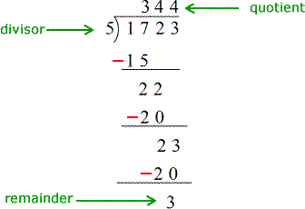SOL 4.4c
Estimate and determine quotients of whole numbers,
with and without remainders.
IMPORTANT WORDS TO KNOW:
(Quizlet Flash Cards)
|
Division
Estimate Dividend Divisor Quotient Remainder |
Division is the operation of making equal groups or shares.
- When the original amount and the number of shares are known, divide to determine the size of each share. - When the original amount and the size of each share are known, divide to determine the number of shares. - Division is the inverse (or opposite) of multiplication! The act of rounding the dividend or using a compatible number to determine a "reasonable" answer; something close to the actual answer. The number of items you will split into smaller groups. The number of groups you will divide the dividend into. The "answer" to a division problem, sometimes includes a remainder. The "leftover" items that did not fit into the smaller groups. The remainder is a part of the quotient. Sometimes written as a whole number, other times as a fraction. Not all division problems have a remainder! (See "Making Sense of the Remainder" at the bottom of this page.) |




